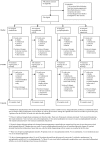Treatment outcome in early diffuse cutaneous systemic sclerosis: the European Scleroderma Observational Study (ESOS)
- PMID: 28188239
- PMCID: PMC5530354
- DOI: 10.1136/annrheumdis-2016-210503
Treatment outcome in early diffuse cutaneous systemic sclerosis: the European Scleroderma Observational Study (ESOS)
Abstract
Objectives: The rarity of early diffuse cutaneous systemic sclerosis (dcSSc) makes randomised controlled trials very difficult. We aimed to use an observational approach to compare effectiveness of currently used treatment approaches.
Methods: This was a prospective, observational cohort study of early dcSSc (within three years of onset of skin thickening). Clinicians selected one of four protocols for each patient: methotrexate, mycophenolate mofetil (MMF), cyclophosphamide or 'no immunosuppressant'. Patients were assessed three-monthly for up to 24 months. The primary outcome was the change in modified Rodnan skin score (mRSS). Confounding by indication at baseline was accounted for using inverse probability of treatment (IPT) weights. As a secondary outcome, an IPT-weighted Cox model was used to test for differences in survival.
Results: Of 326 patients recruited from 50 centres, 65 were prescribed methotrexate, 118 MMF, 87 cyclophosphamide and 56 no immunosuppressant. 276 (84.7%) patients completed 12 and 234 (71.7%) 24 months follow-up (or reached last visit date). There were statistically significant reductions in mRSS at 12 months in all groups: -4.0 (-5.2 to -2.7) units for methotrexate, -4.1 (-5.3 to -2.9) for MMF, -3.3 (-4.9 to -1.7) for cyclophosphamide and -2.2 (-4.0 to -0.3) for no immunosuppressant (p value for between-group differences=0.346). There were no statistically significant differences in survival between protocols before (p=0.389) or after weighting (p=0.440), but survival was poorest in the no immunosuppressant group (84.0%) at 24 months.
Conclusions: These findings may support using immunosuppressants for early dcSSc but suggest that overall benefit is modest over 12 months and that better treatments are needed.
Trial registration number: NCT02339441.
Keywords: Cyclophosphamide; Methotrexate; Systemic Sclerosis; Treatment.
Published by the BMJ Publishing Group Limited. For permission to use (where not already granted under a licence) please go to http://www.bmj.com/company/products-services/rights-and-licensing/.
Conflict of interest statement
Competing interests: ALH has done consultancy work for Actelion, served on a Data Safety Monitoring Board for Apricus, received research funding and speaker's fees from Actelion, and speaker's fees from GSK. JHWD has consultancy relationships and/or has received research funding from Actelion, BMS, Celgene, Bayer Pharma, Boehringer Ingelheim, JB Therapeutics, Sanofi-Aventis, Novartis, UCB, GSK, Array Biopharma, Active Biotech, Galapagos, Inventiva, Medac, Pfizer, Anamar and RuiYi and is stock owner of 4D Science GmbH. OD has received consultancy fees from 4D Science, Actelion, Active Biotech, Bayer, Biogenidec, BMS, Boehringer Ingelheim, EpiPharm, Ergonex, espeRare Foundation, Genentech/Roche, GSK, Inventiva, Lilly, Medac, Medimmune, Pharmacyclics, Pfizer, Serodapharm, and Sinoxa and received research grants from Actelion, Bayer, Boehringer Ingelheim, Ergonex, Pfizer and Sanofi, and has a patent mir-29 for the treatment of systemic sclerosis licenced. WG has received teaching fees from Pfizer. FH has received research funding from Actelion. MEA has undertaken advisory board work and received honoraria from Actelion, and received speaker's fees from Bristol-Myers Squibb. LC has done advisory board work for Gilead and served Data Safety Monitoring Boards for Cytori and Reata. HG has done consultancy work and received honoraria from Actelion. UM-L is funded in part bu EUSTAR/EULAR. JMvL has received honoraria from Eli Lilly, Pfizer, Roche, MSD and BMS. AR receives funding from AstraZeneca. CPD has done consultancy for GSK, Actelion, Bayer, Inventiva and Merck-Serono, received research grant funding from GSK, Actelion, CSL Behring and Inventiva, received speaker's fees from Bayer and given trial advice to Merck-Serono.
Figures



References
-
- Merkel PA, Silliman NP, Clements PJ, et al. . Patterns and predictors of change in outcome measures in clinical trials in scleroderma: An individual patient meta-analysis of 629 subjects with diffuse cutaneous systemic sclerosis. Arthritis Rheum 2012;64:3420–9. 10.1002/art.34427 - DOI - PMC - PubMed
Publication types
MeSH terms
Substances
Associated data
LinkOut - more resources
Full Text Sources
Other Literature Sources
Medical
Research Materials

